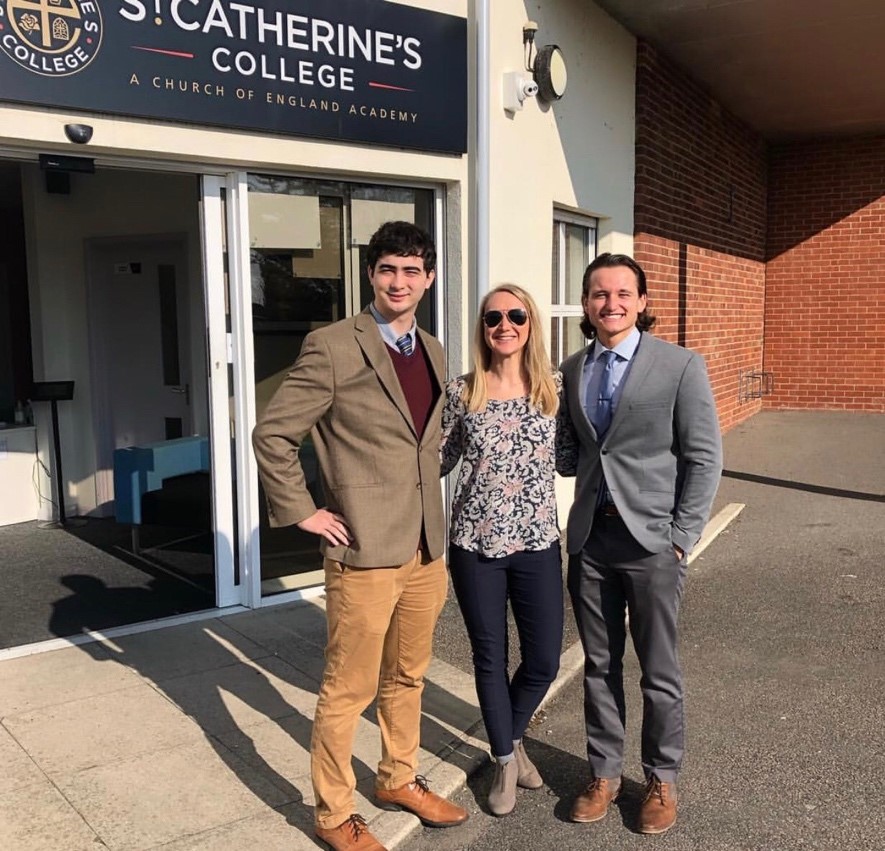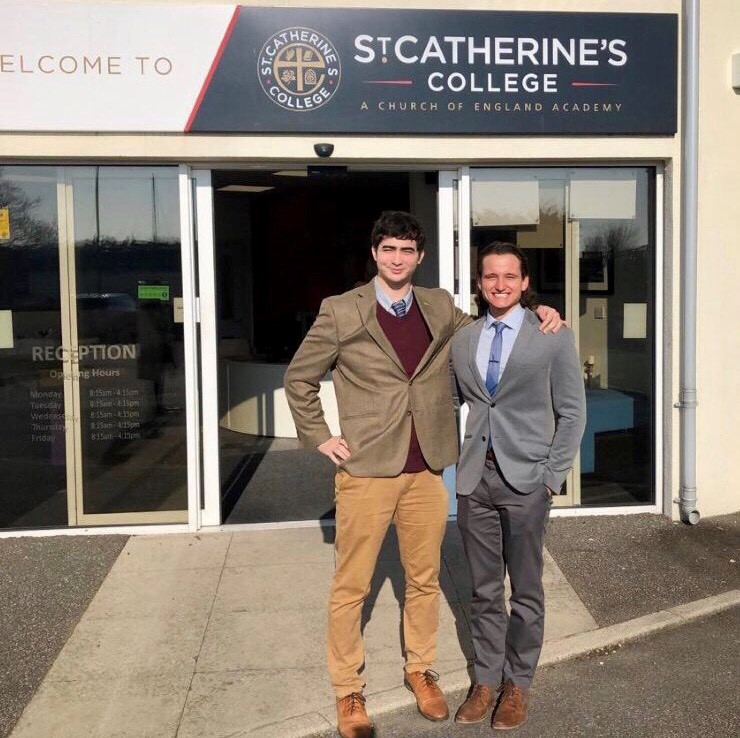Illinois State University students Noah Tang and Zack Maslanka present their impressions of the differences in education between the U.S. and England. Tang and Maslanka are currently student teaching in England for the Spring 2019 semester.

Noah Tang and Zack Maslanka with their favorite Illinois State University Professor, Sara Piotrowski

Noah Tang and Zack Maslanka on their first day of student teaching at St. Catherine’s College in Eastbourne, United Kingdom
Here at St. Catherine’s College in Eastbourne, United Kingdom, we had the opportunity of being exposed to an educational institution that was radically different from what we previously knew about being an educator. The entire school system in the United Kingdom is divided up differently than back in the States. High school in America is equivalent to Secondary school in England. The key difference is that the English “high school” starts at 6th grade opposed to 9th grade as it is in the United States. This forces students to develop a level of maturity much earlier in their educational career. Secondary school in the UK focuses on their General Certificate of Secondary Education exams, commonly known as their GCSEs.
The GCSE exams are a series of assessments that show mastery in certain subject areas for students. Students get the option to choose the specific exam they take that correlates with the field that they are interested in pursuing. Getting a GCSE score is equivalent to achieving a High school diploma. These exams are taken much more seriously than an American ACT or SAT would due to the fact that solely a poor score on the exam results in minimal University options for students. Assisting Year 9 students in their history GCSE exams has been a joy because students are exposed to high-level skill-based objectives in which they practice analyzing in-depth sources on a weekly basis.
The grading system was a huge shock to be exposed to here in the UK. All student work is done in their workbooks which is equivalent to a U.S. student’s notebook. These workbooks are kept in the classroom and consist of all student work and homework from the class. Students are not graded on a points-based system. Students receive house points based on the completion and quality of their work. Similar to the organization of Hogwarts in Harry Potter, St. Catherine’s is divided up into four houses and these houses compete to achieve the most points. Students can receive house points by producing quality work, working well with others, or representing St. Catherine’s in a positive manner. As opposed to giving students grades, students are strictly given feedback and house points. The purpose of this process is to get students prepared for their GCSE exams and not to focus their work on points or grades. We enjoyed this process because students had multiple opportunities to look at the feedback we gave them and correct their work accordingly. Proper feedback is an aspect of the school system in the UK that we intend to bring back to our future classrooms in the States.
At most schools in America, teachers meet with their students on a daily basis and get to form relationships quickly. Here at St. Catherine’s, students come to our history class only three times every two weeks. Initially, this served as a problem for us because we were unaware of how to properly deliver content, how to receive up-to-date feedback, and, most importantly, how to quickly establish healthy relationships in the classroom. Through the help of our cooperating teachers, we were able to discover the proper methods on how to effectively teach at this rate. Students in the United Kingdom are given much more intellectually rigorous material than back in the States. For example, students across the pond practice interpretation and analysis of primary and secondary source documents as early as 6th grade. This was a relief because we found that they were able to handle content similar to what we would give high schoolers back home.
Discipline and classroom management was another difference that we faced early on. Students in the UK are more proper and address adults with immense respect. That being said, there is little room for error in student behavior. We quickly learned the school environment’s classroom management system that gives students three strikes in each lesson. One strike is a warning, the second is a teacher detention, and the third kicks them out of the class. This method is imbedded in the student’s mind to know if they see their name on the board, it is a requirement that they get back to work.
We have also recognized that teachers in the States have a much better relationship with their students. While this is simply one aspect that we observed and does not always apply as true, students in the U.S. seem to form better bonds with their teachers because of the consistency in which they get to interact. This experience has expanded our minds to new possibilities in education and assisted us in becoming flexible in our teaching pedagogy. We have also had the opportunity to teach students content that they are not familiar with. Topics such as Native American history and the Vietnam War are not taught in the British school system. This blank slate allows us to be creative in our lesson planning and helps to ensure the students are eager to learn the content. Our experience in the UK has given us classroom management, formative assessment, and instructional techniques that we are eager to implement in our own classrooms back in the States.

